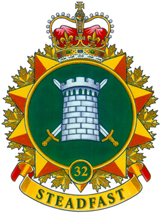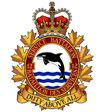Related Research Articles

The British Columbia Dragoons (BCD) is a Primary Reserve armoured reconnaissance regiment of the Canadian Forces. It is based in Kelowna and Vernon, British Columbia. The British Columbia Dragoons are part of 3rd Canadian Division's 39 Canadian Brigade Group.

15th Field Artillery Regiment, RCA, is a Primary Reserve Royal Canadian Artillery (RCA) regiment based in Vancouver, British Columbia, at the Bessborough Armoury. 15th Field Regiment is part of the 39 Canadian Brigade Group of 3rd Canadian Division.
This is the structure of the Canadian Army, as of December 2020.
41 Combat Engineer Regiment is an Army Reserve (militia) unit of the Canadian Military Engineers/Royal Canadian Engineers (RCE) in Alberta, Canada. The unit consists of:

The Canadian Military Engineers is the military engineering personnel branch of the Canadian Armed Forces. The members of the branch that wear army uniform comprise the Corps of Royal Canadian Engineers.
Beginning with establishment of Fort Calgary in 1875, the city of Calgary, Alberta, has had some degree of permanent military presence throughout its history.
4 Engineer Support Regiment is a regiment of the Canadian Military Engineers located at CFB Gagetown, New Brunswick. It is tasked to provide general engineer support to the whole of the Canadian Armed Forces.

The Primary Reserve of the Canadian Armed Forces is the first and largest of the four sub-components of the Canadian Forces reserves, followed by the Supplementary Reserve, the Cadet Organizations Administration and Training Service and the Canadian Rangers.
32 Combat Engineer Regiment is the Primary Reserve (Militia) unit of the Canadian Military Engineers in Toronto, Ontario, Canada. It is assigned to 32 Canadian Brigade Group, part of 4th Canadian Division.

Canadian Forces Base Chilliwack was a Canadian Forces Base located in Chilliwack, British Columbia.

32 Canadian Brigade Group (32CBG) of the Canadian Army is part of the 4th Canadian Division. It is centred on the Greater Toronto Area, as well as Niagara Region and Brantford. It is headquartered at LCol George Taylor Denison III Armoury in Toronto, Ontario.
33 Combat Engineer Regiment (33CER) is the Primary Reserve (Militia) unit of the Canadian Military Engineers in Ottawa, Ontario, Canada. It is assigned to 33 Canadian Brigade Group, part of 4th Canadian Division.

39 Canadian Brigade Group is a Canadian Forces formation of the Canadian Army under the 3rd Canadian Division. The brigade group is composed of Canadian Forces (CF) Primary Reserve units, all of which are based within the province of British Columbia. 39 CBG Headquarters is located at the Major-General B.M. Hoffmeister OC, CB, CBE, DSO Building, 1755 West 1st Avenue, Vancouver.
39 Combat Engineer Regiment was created on 3 May 2008 and amalgamated all the independent field engineer squadrons of the 39 Canadian Brigade Group in British Columbia.
Area Support Unit Chilliwack is a Canadian Forces facility located in Chilliwack, British Columbia.
The 2nd Combat Engineer Regiment(2 CER) is an Australian Army combat engineer regiment located at Gallipoli Barracks in Brisbane, Queensland. It is part of the Australian 7th Brigade, attached to Forces Command (Australia).

12 (Vancouver) Service Company is a Canadian Army Primary Reserve combat service support unit of the Canadian Forces that can fight in a defensive role and provides logistical support to the units within 3rd Canadian Division's 39 Canadian Brigade Group, which consists of all Primary Reserve units in British Columbia.

41 Signal Regiment is a reserve communications unit of the Royal Canadian Corps of Signals. It is part of 41 Canadian Brigade Group in Alberta. The unit consists of:
The 11th Engineer Regiment(11ER) is an Australian Army Reserve engineer regiment trained for sapper/combat engineer and construction engineer operations. While 11 ER was formed on 1 January 2014 as a result of recent Australian Army modernisation efforts, 11 ER's lineage is traced back to early Queensland volunteer engineer units as early as 1879. In 1916, 11th Field Company was formed and during World War I, this unit was renowned for action during the Battle of the Somme and the Hindenburg Line. During World War II, it fought the Japanese during the Kokoda Track campaign and on Bougainville Island. The Regiment's Headquarters is located at Gallipoli Barracks in Brisbane, Queensland with subunits located across Queensland. 11ER is part of 11th Brigade, attached to Forces Command.
References
- ↑ "Lt. Col. James Pemberton Fell Armoury". National Defence and the Canadian Forces. Archived from the original on 7 April 2014. Retrieved 17 April 2014.